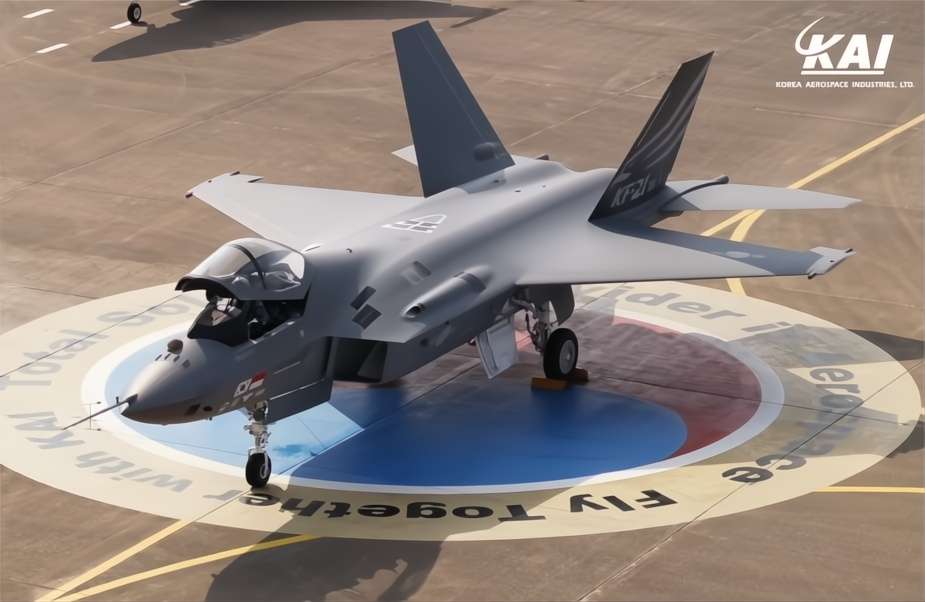Breaking news
South Korea's KAI KF-21 Boromae stealth fighter to enter mass production in 2024.
According to Newsis on December 21, 2023, South Korea's Ministry of National Defense recently announced an increase in its defense budget for the year 2024, totaling 59.42 trillion won (approximately $50.2 billion), which represents a 4.2% rise from the previous year. This budget includes funding for the mass production of the KF-21 Boramae fighter jet, a key component of South Korea's defense strategy.
Follow Air Recognition on Google News at this link
 The KF-21, armed with a 20 mm M61A2 Vulcan rotary autocannon, features a variety of hardpoints for carrying air-to-air and air-to-surface missiles, precision-guided bombs, and anti-ship missiles (Picture source: KAI)
The KF-21, armed with a 20 mm M61A2 Vulcan rotary autocannon, features a variety of hardpoints for carrying air-to-air and air-to-surface missiles, precision-guided bombs, and anti-ship missiles (Picture source: KAI)
The KF-21, a domestically developed supersonic fighter jet, is scheduled to enter mass production in 2024. It's worth noting that the Korea Institute for Defense Analyses (KIDA) recommended reducing the initial production quantity from 40 to 20 units due to technical concerns. To address these concerns and ensure the continuity of the KF-21 project, the budget includes 238.7 billion won (approximately $201.6 million) allocated for its mass production. The Ministry of National Defense aims to commence mass production in the coming year to prevent any military capability gap resulting from the obsolescence of older Air Force fighter jets.
Additionally, 300 million won ($253,000) has been designated for the research and development of the high-altitude interceptor missile (L-SAM-Ⅱ), another 300 million won ($253,000) for the research and development of the medium-range ground-to-air missile (M-SAM) Block-Ⅲ, 1 billion won ($846,000) for the close-range area integrated drone system, and 1.5 billion won ($1.27 million) for the laser air defense weapon Block-Ⅰ.
These allocations aim to create the necessary conditions for the timely initiation and stable execution of these projects, enhancing South Korea's capabilities to respond to security threats. The integrated drone system and laser air defense weapon projects specifically target the prevention of North Korean drone infiltration.
The development of the KF-21 has been a focal point for South Korea, with more than 140 test flights completed to date, confirming the jet's basic operational stability and the proper functioning of major avionics systems. The South Korean Defense Acquisition Program Administration (DAPA) is preparing for mass production, including assessments of provisional combat suitability and feasibility studies.
Furthermore, integrating the KF-21 with advanced weaponry, such as the Meteor beyond-visual-range air-to-air missile (BVRAAM), is a significant point in this project. For example, Korea Aerospace Industries (KAI) has already conducted trials in preparation for the first live-fire test of the Meteor missile, scheduled for early 2024.
The integration of the Meteor BVRAAM into the KF-21 represents a significant milestone, as the KF-21 is the first non-Western platform to incorporate this advanced European air-to-air armament. A live-fire test of the Meteor BVRAAM from a KF-21 is scheduled for early 2024, marking a crucial step in the development of the KF-21 project and the integration of this strategic weapon. MBDA, the company behind the Meteor missile, has expressed confidence in the growth prospects of the KF-21 program as it matures.
The KF-21 Boramae, manufactured by Korea Aerospace Industries (KAI), is an advanced fighter aircraft developed as a collaborative effort between South Korea and Indonesia. It has been designed to serve as both an air superiority fighter and a multirole combat aircraft. The KF-21 program aims to replace South Korea's aging F-4D/E Phantom II and F-5E/F Tiger II aircraft with a modern and capable fighter.
One of the notable features of the KF-21 is its stealthy airframe, which surpasses the stealth capabilities of fourth-generation fighters. While it does not initially have internal weapon bays like fifth-generation fighters, there are plans to introduce internal bays in later development phases. The aircraft is equipped with advanced avionics, including an Active Electronically Scanned Array (AESA) radar, an Electro-Optical Targeting Pod (EO TGP), an Infra-Red Search and Track (IRST) system, and an Electronic Warfare suite (EW suite).
The KF-21 is powered by two General Electric F414-GE-400K turbofan engines, offering impressive thrust levels both in dry and afterburner modes. It can achieve a maximum speed of 2,200 km/h (1,400 mph) and has a combat range of 1,000 km (620 mi). The aircraft can be armed with a wide array of weaponry, featuring a 20 mm M61A2 Vulcan rotary autocannon and a variety of hardpoints for carrying air-to-air and air-to-surface missiles, precision-guided bombs, and anti-ship missiles.


























